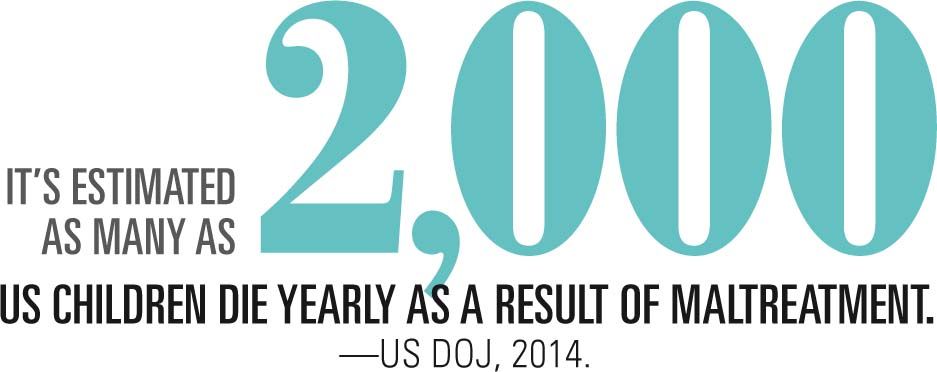Brittle or battered?
Many pediatricians need to step up their game in understanding and diagnosing rare disease processes whose symptoms can mimic those of child abuse.
Many pediatricians need to step up their game in understanding and diagnosing rare disease processes whose symptoms can mimic those of child abuse, said Matthew Cox, MD, FAAP, in his presentation "Brittle or battered? Medical evaluation of multiple fractures in young children" at the American Academy of Pediatrics National Conference.
Proper evaluation requires a detailed medical history, a comprehensive examination, laboratory evaluations, and radiographic evaluation and consultation with appropriate experts such as radiologists and orthopedic surgeons, he told attendees.
Along with vitamin D status, laboratory tests can detect or rule out inherited bone diseases, secondary hormone imbalances, and abnormalities in calcium or phosphorus that can occur with a primary bone disease, Cox said. Radiographs can reveal overt and sometimes covert problems such as fraying at the distal end of the metaphysis, osteopenia, and Wormian bones. Additionally, one must consider not only the child's history, but also a detailed family history-particularly parental history as it relates to musculoskeletal problems.

Cox said that misdiagnosing such problems can bring disastrous results for the child and/or family. Physicians may wrongly identify an underlying disease process as evidence of abuse, and vice versa. One case he described involved a child who presented with fractures of the femur and hand at the same visit. The child had a limited history of trauma. The child returned to the doctor with additional fractures that could not be readily explained and was placed in foster care.
Related: Cutaneous clues of child abuse
This example illustrates the importance of parental history. The child's maternal history, which included osteogenesis imperfecta, initially was unknown. Fortunately, the pediatric radiologist's review of films caught the subtle findings of this disease.
In such cases, establishing a diagnosis rests not on any single feature, but on the entire constellation of medical findings. In distinguishing abuse from disease processes, Cox said, the underlying theme is that there are many potentially suspicious features, but nothing definitive. Successful diagnosis demands considering all pieces of information together.
Matthew Cox, MD, FAAP, is medical director of the Children at Risk Evaluation Services (CARES) program at St. Luke's Health System, Boise, Idaho. He reports no relevant financial interests.
NEXT: Commentary
COMMENTARY
Most childhood injuries are not a result of abuse. However, when abuse is suspected, it is important to also consider medical conditions that mimic trauma or that make the child more vulnerable to trauma because of bleeding abnormalities or fragile blood vessels or bones.
Abnormalities of the blood and circulatory system include idiopathic thrombocytopenic purpura (ITP), a bleeding disorder that can occur spontaneously in otherwise healthy children. Sometimes these children have several unexplained bruises that suddenly appear. Other blood disorders that can create potentially suspicious symptoms include hemophilia and von Willebrand disease. Remember that some inherited blood disorders may be mild enough that bruising problems do not appear until later in childhood.

Many mimics of abusive trauma are less common than abuse, but one must always consider them to ensure that an appropriate and complete medical evaluation is done. This could represent a practice change for many of the practitioners currently evaluating children's injuries. For example, a practitioner ordering a skeletal survey to work up an infant for possible abuse may also consider tests for bone fragility or bleeding disorders, depending on the characteristics of the injury.
There are rare circumstances in which the injury alone is enough to suspect or diagnose abuse. If a young child presents with an obvious, devastating injury for which there is no explanation, or a nonmobile infant presents with unexplained bruising, abuse should be strongly considered. The challenge is that practitioners need to consider child abuse-as well as other nonabusive causes-on a more consistent basis. Being aware of bias tendencies and the need to consider all possibilities in young children with injuries will improve the detection of child abuse, as well as less common mimics of trauma.
Overall, it is important for physicians to "think common, remember rare." Consider obvious possibilities that could account for a child's suspicious symptoms, but always remember the rare, odd, or unusual medical condition that could also explain the findings. When one hears hoofbeats, think horses, but remember zebras.

Mr Jesitus is a medical writer based in Colorado. He has nothing to disclose in regard to affiliations with or financial interests in any organizations that may have an interest in any part of this article.